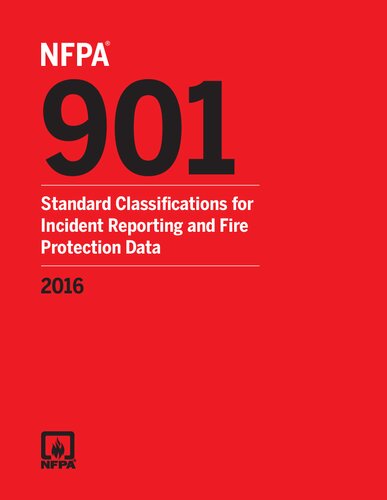NFPA 901 standard classifications for incident reporting and fire protection data 2016th Edition by National Fire Protection Association ISBN 9781455913077 1455913073
$50.00 Original price was: $50.00.$25.00Current price is: $25.00.
NFPA 901 standard classifications for incident reporting and fire protection data 2016th Edition by National Fire Protection Association – Ebook PDF Instant Download/Delivery: 9781455913077 ,1455913073
Full download NFPA 901 standard classifications for incident reporting and fire protection data 2016th Edition after payment

Product details:
ISBN 10: 1455913073
ISBN 13: 9781455913077
Author: National Fire Protection Association
NFPA 901 standard classifications for incident reporting and fire protection data 2016th Edition Table of contents:
Chapter 1 Introduction
1.1 Scope.
1.2 Purpose.
Chapter 2 Referenced Publications
2.1 General.
2.2 NFPA Publications.
2.3 Other Publications.
2.4 References for Extracts in Mandatory Sections.
Chapter 3 Definitions
3.1 General.
3.2 NFPA Official Definitions. (Reserved)
3.3 General Definitions.
Chapter 4 Objectives
4.1 Abbreviations for States and Provinces.
4.2 Abbreviations for Street Types.
4.3 Objectives.
4.4 Guiding Concepts for a Reporting System.
4.5 Fact Finding.
4.6 Data Processing.
4.7 Data Use.
4.8 Standard Classifications.
4.9 Nonclassified Data.
Chapter 5 Incident Identification and Location
5.1 Purpose and Application.
5.2 Limitations.
5.3 Incident Number.
5.4 Exposure Number.
5.5 Shift.
5.6 Number of Alarms.
5.7 Incident Events.
5.8 Day of Week.
5.9 Incident Location.
5.10 Business, Tenant, or Occupant.
5.11 Property Owner.
5.12 Fire Service Personnel.
Chapter 6 Property Use
6.1 Administration.
6.2 Limitations.
6.3 Discussion and Examples.
6.4 Building Code Occupancy Class.
6.5 General Property Use.
6.6 Specific Property Use.
6.7 Mobile Property.
6.8 Property Management.
6.9 On-Site Material.
Chapter 7 Structure Characteristics
7.1 Purpose and Application.
7.2 Limitations.
7.3 Definition of Structure.
7.4 Structure Features.
7.5 Allowable Occupancy.
7.6 Compartment Characteristics.
7.7 Compartment Quality.
7.8 Roof Covering.
7.9 External Exposure.
7.10 Perimeter Access.
7.11 Electrical Service Quality.
7.12 Heating Service Quality.
7.13 Control of Smoking Practices.
7.14 Fuel Control.
7.15 Obstacles to Rescue and Fire Control.
Chapter 8 Incident Origin
8.1 Purpose and Application.
8.2 Discussion and Examples.
8.3 Area of Fire Origin or Release of Hazardous Materials.
8.4 Equipment Identification.
8.5 Heat Source.
8.6 Material Identification.
8.7 Ignition.
8.8 Level of Origin.
8.9 Occupant of Room or Space of Origin at Time of Ignition.
8.10 Activity Involved in Fire Start.
8.11 Wildland Fuel Model.
8.12 Fire Danger Rating Class.
Chapter 9 Incident Growth and Spread
9.1 Purpose and Application.
9.2 Contributing Factors.
9.3 Flame Development.
9.4 Smoke Development.
9.5 Fire Detection and Alarm.
9.6 Weather Information.
Chapter 10 Detection, Alarm, and Control Equipment
10.1 Administration.
10.2 Limitations.
10.3 Automatic Detection.
10.4 Automatic Alarm Transmission.
10.5 Protection.
10.6 Water Supply.
10.7 Performance of Fire Spread Limitation Features.
10.8 Performance of Exit System.
Chapter 11 Fire Department Intervention
11.1 Purpose.
11.2 Limitations.
11.3 Incident Type.
11.4 Condition of Fire on Arrival.
11.5 Type of Action Taken.
11.6 Fire Suppression Factors.
11.7 Method of Extinguishment.
11.8 Fire Service Resources.
11.9 Outside Fire Service Assistance.
Chapter 12 Demographic Data
12.1 Purpose and Application.
12.2 Limitations.
12.3 Discussion.
12.4 Age/Date of Birth.
12.5 Sex.
12.6 Race and Origin.
12.7 Affiliation.
12.8 Relationships.
12.9 Familiarity with the Incident Area.
12.10 Location of Person with Relation to Point of Origin.
12.11 Factors Preventing Escape.
12.12 Mobility of Occupant.
Chapter 13 Property and Human Loss
13.1 Purpose and Application.
13.2 Limitations.
13.3 Summary Data.
13.4 Extent of Damage.
Chapter 14 Casualty Data
14.1 Purpose and Application.
14.2 Limitations.
14.3 Case Severity.
14.4 Apparent Symptom(s).
14.5 Part(s) of Body.
14.6 Casualty Type by Situation Found.
14.7 Human Factors Contributing to Injury.
14.8 Situational Factors Contributing to Injury.
14.9 Medical Care for Casualty.
14.10 Activity at Time of Injury.
14.11 Regular Fire Service Work Assignment.
14.12 Physical Condition at Time of Injury.
14.13 Status of Injured Prior to Alarm at Which Injury Occurred.
14.14 Activity at Time of Fire Service Injury or Accident.
14.15 Where Fire Service Injury Occurred.
14.16 Cause of Injury.
14.17 Factor Contributing to Injury.
14.18 Object Involved in Injury.
14.19 Protective Equipment.
Chapter 15 Prehospital Care
15.1 Administration.
15.2 Limitations.
15.3 Discussion and Examples.
15.4 Emergency Medical Responder.
15.5 Patient Physical Condition.
15.6 Cardiac Condition/Assessment.
15.7 Prehospital Care Provided.
15.8 Medication.
15.9 Patient Disposition.
15.10 Patient Transport Services.
Chapter 16 Hazardous Materials Data
16.1 Purpose and Application.
16.2 Limitations.
16.3 Discussion and Examples.
16.4 Hazardous Materials Identification.
16.5 Container Description.
16.6 Release Information.
16.7 Responsible Persons.
16.8 Disposition of Incident.
Chapter 17 Intentionally Set Fires
17.1 Purpose and Application.
17.2 Case Management.
17.3 Personal Factors.
17.4 Incendiary Devices.
17.5 Scene Information.
17.6 Juvenile Firesetter.
Annex A Explanatory Material
Annex B Informational References
Index
People also search for NFPA 901 standard classifications for incident reporting and fire protection data 2016th Edition:
nfpa class 1 storage
nfpa classification chart
nfpa class x
what is nfpa 90a
is nfpa a standard
Tags: National Fire Protection Association, NFPA 901, standard classifications, fire protection data
You may also like…
Uncategorized
NFPA 1965 Standard for Fire Hose Appliances 2014 Edition National Fire Protection Association
Technique - Regulatory Literature
NFPA 92 Standard for Smoke Control Systems 2021 Edition National Fire Protection Association
Uncategorized
Uncategorized
Engineering - Aerospace Engineering
NFPA 409 : Standard on Aircraft Hangars , 2022 Edition National Fire Protection Association
Uncategorized
Uncategorized
NFPA 10 Standard for Portable Fire Extinguishers 2022 Edition National Fire Protection Association











